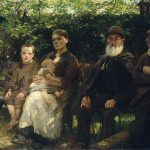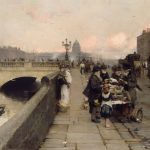
Jack Butler Yeats, born on August 29, 1871, in London, England, was an Irish artist, illustrator, and writer, renowned for his contribution to the development of modern Irish painting. The youngest child of the portrait painter John Butler Yeats and brother to the famous poet William Butler Yeats, Jack grew up in a family deeply entrenched in the arts and literature. This environment profoundly influenced his creative path, setting the stage for a prolific career that spanned over seven decades.
From an early age, Yeats’ artistic talents were evident. He moved to Sligo, Ireland, to live with his grandparents after his birth, and the landscapes and people of Sligo would become enduring subjects in his work. This connection to the land and its stories became a cornerstone of his artistic expression, imbuing his paintings with a deep sense of place and emotional resonance.

Yeats began his formal art education at the South Kensington School of Art, London, in 1887. However, it was his return to Ireland and subsequent enrollment at the Metropolitan School of Art in Dublin that marked the beginning of his lifelong engagement with Irish culture and scenery. During these formative years, he also started to illustrate for various magazines and books, showcasing his versatility and skill in handling different mediums.
Becoming Successful
In the early 20th century, Yeats’ work began to gain significant attention. He initially made his mark with watercolors and illustrations, but his focus shifted increasingly towards oil painting. His early pieces were characterized by a more conventional, illustrative style, reflecting the influence of Romanticism and the Pre-Raphaelites. However, as his career progressed, Yeats’ style evolved dramatically, becoming more expressionistic and abstract. This transformation was partly influenced by his exposure to modernist movements through his travels in Europe and his involvement with the RHA (Royal Hibernian Academy) and later the Irish Museum of Modern Art.

Yeats was deeply committed to portraying the Irish life and landscape, often focusing on themes of identity, memory, and the passage of time. His work from the 1920s and 1930s depicts scenes of everyday life, horse races, circuses, and the rugged Western landscape, all imbued with a dynamic, emotional force. His use of vibrant colors and loose brushwork added a dramatic intensity to these subjects, making them resonate with viewers on a visceral level.
The Irish Civil War and the struggle for independence profoundly impacted Yeats, influencing the themes and mood of his work. He was not overtly political in his paintings, but the tumultuous events of his time are reflected in the somber tones and turbulent scenes of some of his mid-career works. Despite this, Yeats rarely depicted violence directly, preferring to focus on the human and emotional aspects of these events.

As Yeats aged, his work became even more abstract and experimental, reflecting his continued exploration of the possibilities of paint. In his later years, he was particularly fascinated by the theme of memory and the subjective experience of reality. His paintings from this period are characterized by a bold use of color and form, with less emphasis on clear narrative content. This late style has been compared to the work of Expressionist and Abstract Expressionist artists, showcasing Yeats’ place within the broader context of modern art.
Irish Renaissance Man
Beyond painting, Yeats was also an accomplished writer, contributing essays, plays, and novels to the Irish literary scene. His literary work, though less known than his visual art, explores similar themes of Irish identity, folklore, and the human condition. This dual legacy as both a painter and writer highlights the breadth of his creative vision and his significant contribution to Irish culture.
Jack B. Yeats passed away on March 28, 1957, in Dublin, Ireland. His work continues to be celebrated for its profound emotional depth, technical innovation, and its vital role in the development of Irish modern art. Yeats was not just a painter of the Irish scene; he was a pivotal figure in articulating the nation’s cultural renaissance in the early 20th century. Through his eyes, we witness the transformation of Ireland, from its rural past to its post-independence future, rendered in strokes that are at once deeply personal and universally resonant.

Today, Yeats is honored as one of Ireland’s most important artists, with his work held in major collections worldwide, including the National Gallery of Ireland, where the Jack B. Yeats room displays a comprehensive selection of his paintings. His legacy is not just in the beauty and depth of his art but in his enduring influence on generations of Irish artists who have followed in his footsteps, exploring and expanding the boundaries of what Irish art can be. Through his innovative approach and profound connection to his homeland, Jack B. Yeats has secured his place in the pantheon of great artists, a visionary who captured the spirit of Ireland in every brushstroke.




